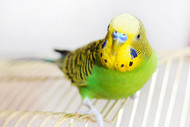Budgerigar Fact Sheet
Posted by Budgie Parrot, Budgie Facts, Budgerigar Diet, Budgerigar Behaviour, Budgerigar Training, Budgie fact sheet, on 9/1/2024
Rosemary Low reveals more about the Budgerigar.

Common name:
Known as ?Parakeet? in the USA.
Adult length:
Wild type 7in (18cm) and slim; exhibition type larger and heavier.
Adult weight:
30-35g.
For everything you need for a Budgerigar please click here.
Expected lifespan:
Exhibition type birds about seven years, wild type double or even longer.
Status in wild:
common but nomadic.
Origin:
Interior of Australia

Suitability
It would be hard to find any other species, avian or mammalian, that is a more suitable companion in the home. Budgerigars are easily tamed (when acquired young), pretty, relatively quiet, quite charming in their behaviour, very lovable and easy to care for.
They do not take up much space and equally importantly, unlike hand-reared birds, you are unlikely to have behavioural problems with them!
Budgerigars introduced me to bird-keeping when I was twelve years old ? and I have never lost my affection for them.
Sexing a Young Bird
In ?normal? coloured birds the cere is an indication of sex (very convenient, as this is not true of any other member of the parrot family).
In young males the cere is purplish or pinkish; in young females the cere is very light blue, often with the area around the nostrils white.

Sexing an Adult
In lutinos, albinos and pieds the cere does not attain the deep blue of other adult males but usually remains a purplish shade.
In all adult females the cere is deep brown (sometimes rough in appearance, rather than smooth) if the bird is in breeding condition. It fades to light blue in a female not in breeding condition.
Choosing a Colour
Colour has no bearing on talking ability. However, the sight of red-eyed birds might not be as good as in other colours.
Mimicry
Almost all males, acquired when young and in a household where they receive a lot of attention, will become extraordinarily good mimics. True the voice is small but the vocabulary can exceed that of any other species, even a Grey Parrot.
Females seldom learn to mimic and their temperament might not be quite as sweet as that of a male.
Cage
Unfortunately there are some bad designs available. Never buy a cage that is taller than it is long. Budgies (and all other Parrots) need horizontal space ? not vertical. Buy the largest cage you can afford.
Cages with horizontal bars are better as it is easier for the occupant to climb about.
Four perches are provided with most cages. If these are plastic use two in front of the food containers and keep the other two in reserve.
Click here for the best Budgie cages.

Cut branches from apple or willow to use in the higher part of the cage and renew them every month. Do not let them become worn and shiny. Budgies receive a lot of benefit from perches of different dimensions and from gnawing the bark.
Toys
Swing, mirror and small plastic toys are favourites. If you offer a bell, make certain it is of good quality and not one with a clapper that could trap the beak. Dozens of toys for Budgies are available here.
Food
Buy a good quality Budgerigar mixture in a bag or packet ? not a loose mixture whose age and origin is unknown and which could have been contaminated. In addition offer a millet spray at least twice a week and apple and/or greenfood daily.
When available seeding grasses, seeding dock and chickweed, and young leaves of dandelion and smooth sowthistle are excellent additions to the diet, providing elements, such as Vitamin A, that are not present in seed.
Cultivated greenfoods such as spinach or spinach beet and rocket are also suitable, as is broccoli. A piece of carrot wedged in the bars might also be appreciated.
All these foods should be offered at the time of acquisition because older birds might be reluctant to sample them. Grit should always be available, also an iodine nibble because Budgies are susceptible to thyroid problems.
Choose from lots of Budgie food here.

Training
Start to train a young Budgie soon after acquisition to ?Step up!? so that he can be returned to his cage when required. This is important.
Try to practice this within the cage before letting him out otherwise a stressful chase to get him back in will occur, damaging your relationship.
Slowly and gently approach him when he is perched, placing your forefinger just above his legs and pushing very gently so that he steps on to your finger.
If at first he does not allow this close approach, spend a lot of time just talking to him until you have won his confidence.
Praise him when he steps up and give him a piece of millet, which should not be available until this training is perfected.
For many more Budgie foods, toys, cages, accessories and supplements visit the Budgerigar section of our website.

